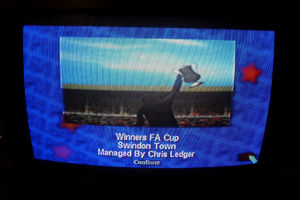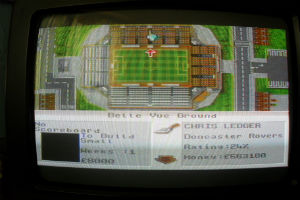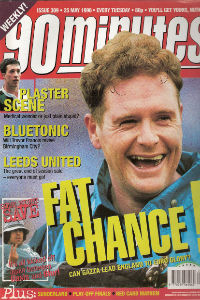 Porting football management games to consoles can be tricky.
Porting football management games to consoles can be tricky.
After all, it is a mammoth task to squeeze as many statistics and leagues as possible in one Sony PlayStation disc.
And, over the years, the genre has technologically progressed.
For example, Codemasters, the makers of ‘LMA Manager 2006’, launched a downloadable patch in early 2006 that updated squads and statistics in line with the latest transfer window. The aforementioned PlayStation 2 game was the first of its kind to offer this feature.
But imagine trying to fit the latest leagues, players and options in just one cartridge.
Gremlin Interactive attempted this in 1999, when they released ‘Premier Manager 64’ for the Nintendo 64, and they came mighty close to making it work.
Enter the PlayStation
 For starters, and perhaps most importantly, the gameplay is more than adequate.
For starters, and perhaps most importantly, the gameplay is more than adequate.
While its Career mode, where you can manage one of ten Division Three teams, is not as addictive as Sports Interactive’s ‘Football Manager’ series, it is a game that merits repeated plays.
And taking an underdog to the Super League – essentially, the UEFA Champions League – is very rewarding.
The game’s difficulty level, however, is arbitrary, meaning that winning the Premier League with Charlton Athletic is just as likely as being involved in a relegation scrap with Tottenham Hotspur.
But the flaws of ‘Premier Manager 64’ are all too evident when it is compared to its PlayStation counterpart, ‘Premier Manager Ninety Nine’.
A number of the latter’s features – including profile pictures of footballers, two Italian leagues (Serie A and Serie B), and the ability to change the screen position – were excluded from the Nintendo 64 version.
The TV-style match highlights were kept, though, but many of its selling points were sacrificed. Replays, goal details (such as speed and distance) and name bars were all ditched and, unlike the PlayStation version, Barry Davies’ commentary lacked variation.
The highlights on both versions were graphically undeveloped by 1999’s standards, but the Nintendo 64 version looked a bit like a low-budget conversion.
To a certain extent, this is understandable. The capacity of the ‘Premier Manager 64’ cartridge is 128 Megabits – twice the size of the typical Nintendo 64 cartridge and equal to 16 Megabytes.
In contrast, a bog-standard PlayStation CD comfortably contains over 600 Megabytes. This meant that the Nintendo 64 was not suited to stand-alone features and options, such as pre-rendered music and film, hence why so many various presentational enhancements had to be scrapped from ‘Premier Manager 64’.
Konami’s ‘Mystical Ninja Starring Goemon’ was another example of this problem, as it needed a 16 Megabyte cartridge just to fit two short, but delightfully eccentric, songs (‘I Am Impact!‘ and the opening theme). This led to a £60 price tag and disappointing sales.
64-bit graphical enhancements
The Nintendo 64, however, was still a powerful machine, and capable of other pre-rendered elements that were not imaginable on the PlayStation and Sega Saturn.
And, thanks to its Reality Immersion system, it had the main components of a £10,000 Silicon Graphics machine.
According to N64 Magazine, this meant that – in games such as ‘Super Mario 64’ and ‘Pilotwings 64’ – it was possible to create massive 3D worlds “just by specifying a few polygon co-ordinates”.
Games could also be anti-aliased – which meant that jagged lines were minimised – while frame rates were maintained without resorting to fog.
The console’s other advantages, such as texture mapping and detailing, led to the critical acclaim of Major A’s ‘International Superstar Soccer 64’.
It was the Konami subsidiary’s first attempt at using motion capture and programming with polygons, and the game ran around 100 times faster than its Super NES counterparts.
Yasuo Okuda, who directed and co-programmed the game, told N64 Magazine that although the game could be converted to the PlayStation or Saturn, “we’d [Major A] have to delete quite a bit from it because of memory size restrictions”.
Katsuya Nagae, who was in charge of Konami Computer Entertainment Osaka’s research and development department, also added:
“The N64 is definitely the best machine to write a soccer game for, because it uses cartridges rather than CDs. Other machines have a limited memory to store information read from the CD, but the N64 can get information from the cart at any time. The PlayStation, on the other hand, has to load everything in and store it in its memory.” (April 1997, p.82-83.)
This meant that ‘International Superstar Soccer 64’ was able to master the Nintendo 64 in the same way as Nintendo’s two launch games – by using its 3D powers to produce real-time graphics.
But ‘Premier Manager 64’ was graphically basic, meaning that the concept of creating 3D worlds was irrelevant for such a statistically and text-heavy game.
Even though its processing time – which was regarded, for example, as the main fault of ‘LMA Manager 2003’ on the PlayStation 2 – was much faster than many 128-bit console football management games, Gremlin’s mastery of the Nintendo 64 was always going to be lower than Major A’s capabilities.
16-bit depth
 But what remains puzzling is the fact that the Sega Mega Drive version of ‘Premier Manager’ – released in 1995, with only 32 Megabits – has more detailed options than the Nintendo 64 AND PlayStation versions.
But what remains puzzling is the fact that the Sega Mega Drive version of ‘Premier Manager’ – released in 1995, with only 32 Megabits – has more detailed options than the Nintendo 64 AND PlayStation versions.
In ‘Premier Manager 64’ and ‘Premier Manager Ninety Nine’, for example, players could only choose between three sponsors.
In the Mega Drive version, however, players could decorate their ground with a variety of, mainly Sega-themed, advertising hoardings.
Floodlights, scoreboards, covered areas, under soil heating, car parks and a supporters’ club could also be developed, as could the stadium’s capacity and safety rating.
The 32 and 64-bit versions, though, only had two options: improving stadium facilities and increasing its capacity.
The Mega Drive version also allowed players to buy players via a transfer auction – which made for a refreshing change – with options to develop a youth team, and appoint coaches and physios.
Overdrafts could be extended, details about referees were provided, and a fictional fax machine displayed the latest results and transfers.
But none of these features were available on the Nintendo 64 and PlayStation versions, while the original console version of ‘Premier Manager’ offered a wider range of tactical options.
It’s still enjoyable
 Although the limited number of features and options are frustrating, ‘Premier Manager 64’ remains one of the best football management games on a home console.
Although the limited number of features and options are frustrating, ‘Premier Manager 64’ remains one of the best football management games on a home console.
‘Premier Manager Ninety Nine’ on the PlayStation, for example, has a couple of minor bugs, and ‘Premier Manager’ on the Mega Drive has a learning curve that is too steep for novice gamers and thus lacks immediacy.
And, even in the 128-bit era, simplistic options were still a niggling issue. For example, Ben Richardson’s review of ‘LMA Manager 2006’ in Official UK PlayStation 2 Magazine included the following passage:
“Selecting tactics is pretty painless as well, although a main ‘summary’ page would have been a nice addition, as the constant switching between windows can cause confusion as you try to figure out what you’ve actually changed. Mid-match options are a little restrictive, too. You can assign only four tactics to trigger during a game, and you’re unable to use them together – for instance, like setting up Counter Attack and Wing Play at the same time, which makes complete sense to us.” (December 2005, p.108.)
‘Premier Manager 64’ has all the makings of a brilliant game: it is easy to play and navigate, while having enough challenge to ensure that it has an excellent lifespan.
Despite its noticeable problems, it’s still an enjoyable game. But it will leave the more cynical player feeling short changed.
If only Gremlin could have produced a console-based game that had the accessibility of ‘Premier Manager 64’ and the depth of earlier versions. It certainly would have made for a different conclusion.

